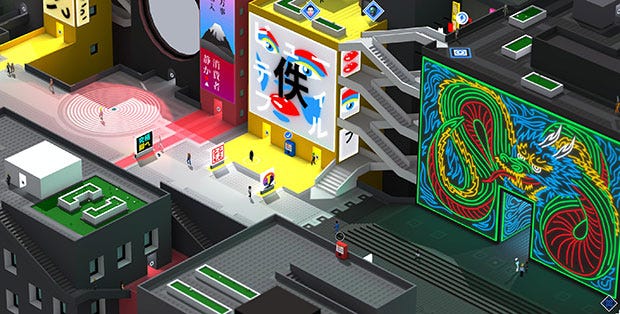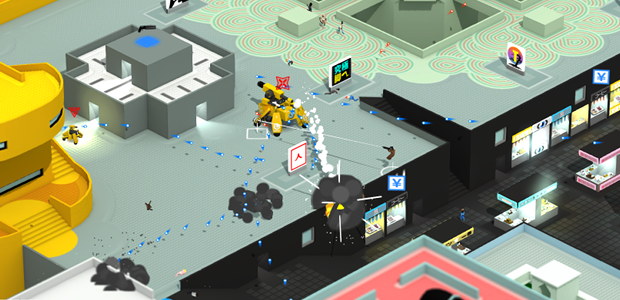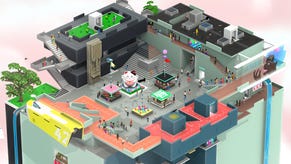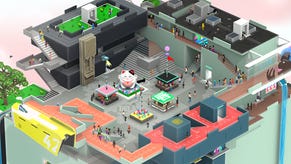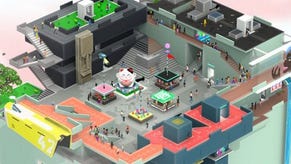Wot I Think: Tokyo 42
Monument Miami
Tokyo 42 [official site] is a game of games. It comes across as having the pure and earnest intention to hybridise everything that has been most beloved in games from the last half-decade (and a couple from decades earlier), and then adds in cats and samurai swords for good measure. Inevitably, it doesn't all work, but moments of half-madcap, half-measured brilliance glimmer through a patina of low-level frustration.
Tokyo 42 is: GTA's violent sandbox and snarky talking heads; Hitman's strategic kills; Hotline Miami's precision kills at speed; Monument Valley's stark lines and soft colours and mechanical camera; Mirror's Edge's urban parkour and mono-coloured buildings; Gunpoint's mathematical physics and rapid restarts; ghosts of cyberpunk games past, and maybe even the tiniest bit of Fez in the camera rotation puzzles. And, of course, the original Syndicate, the original isometric future city strategic murder sim. A tombola of ideas and inspirations, clad in art that mixes the surreal with the mechanically logical.
It's not this sugar-high megamix like Retro City Rampage, however, but more folding all of the above into a DIY assassination and parkour game set across an openish world in the form of bright-as-can-be cyberpunk Tokyo. There are motorbikes and swords and sniping yogis from half a city away, and wi-fi cats and rival assassins and a button expressly dedicated to putting on your trenchcoat just to look cool.
Throughout, there's a choice between a pure stealth approach, open assault or a hybrid of the two, with rewards to be had for not being spotted or killing every enemy on a mission. In this, Tokyo 42 feels like a lo-fi abstracted Hitman. Figuring out a safe route through its crowded spaces is its chief delight. More than anything, though, this is a game about camera control.
Rather than having free camera movement, you're forever rotating it in 90 degree increments, partly just to be able to see where you are and where you're trying to get to in this isometric world, and partly to 'create' new paths - from one angle a jump is impossible, but from another a roof and a window left might line up just so. There's no surrealistic environment-morphing here (still waiting for that Dark City game, please), it's simply a matter of alignment - what looks adjacent or perpendicular from one angle turns out to be divided by a vast and lethal chasm if gazed at from another.
To play T42 on PC is to be constantly hammering Q and E to rotate the camera, and often doing so in the wrong direction because it's not always apparent how the image will shift, thus obfuscating your view further. The key challenge in T42 is so often trying to work out where something entirely visible actually is. What looks like a sure jump to a platform or to grab a floating collectible winds up with you sailing off to one side of it even though it looks like you should hit it dead on.
I've died many times purely because the camera got in my way. I found this particularly, gruesomely true during parkour race missions and motorbike chase sequences. Flip-over-the-table stuff, sadly.
In the slower sequences - long, stealthy climbs up a mountain or staircases or through a twisting maze of external corridors - the problem is simply searching for and often failing to find the angle from which your route forwards is visible. I often found myself going nowhere, my character running endlessly into a low wall or planter I simply couldn't see, and this can regularly ascend from annoyance to fatality, as precious seconds trickle away until a roaming guard wanders within sight range.
I'm not arguing that this is an inherently flawed system. It can work well, when a quick tap of the button effectively rewrites the logic of a scene and brand new paths become clear, or a deft sequence of moves has you navigate around a narrow cubist tower effortlessly. But perhaps four angles is simply too few, or some light-touch auto-rotation in some of the more hectic scenarios would tone down the frustration.
T42 works so much better when I don't really have to worry about the camera, or when it's just a matter of getting a better view rather than requiring camera manipulation to understand how this space works. I.e. when I sneak around a maze of stairs and rooftops silently killing everyone with a katana until I reach my well-guarded target, or when I'm spotted and find myself in a frantic, bunny-hopping gunfight. Projectiles move a little slowly in T42, so there's almost a bullet hell element in there, these big pastel-coloured slugs creating a ring of death around you.
Death comes fast and often in Tokyo 42 - by shooting or by falling to the unseen streets far below its skyscraping buildings - but fortunately it's entirely designed to cater for your fragile mortality. Coffee machines act as save points, and invariably there will be one proximate to your current mission. Rare's the time that you'll lose more than four or five minutes of progress, but, Hotline Miami-style, sometimes that progress can be deeply intense and require an exact plan of action.
You will throw yourself upon the same rocks time and again, balancing the knowledge that you need to wait here and precision-strike there with the impatience of having to do it all over again and again and again. Naturally, finally succeeding brings immense satisfaction, and each mission is generally so bite-sized that you will experience this rollercoaster of emotion several times per hour.
Unfortunately, when combined with the oft-irksome camera, this spiking difficulty sometimes saw me hit the wall and give up on a few missions. The structure of Tokyo 42 is such that there were several alternative missions I could do instead, at least for a time, but there were moments were everything available to me seemed too gruelling to countenance.
Sure, I could just free-form wander/slaughter my way around the city, but to its credit Tokyo 42 has no pay-off for random acts of urban violence and so that kind of spree held little thrall for me, though I should warn that there are story elements touching on urban terrorism that may make some players feel uncomfortable.
It's billed as an open world game of sorts, but the reality is that you're generally choosing which order you accept your missions in, whether you take an assault or stealth path through them, and whether or not to embark on side-quests or seek aesthetic-only upgrades hidden in hard-to-reach places. There's a small element of getting into random trouble, with a few guard posts making certain areas of the city hostile or small packs of roaming, armed enemies, but again, mostly it's about picking which mission when.
Good news is, during these missions the game regularly chucks new ideas and challenges into the mix, even though the essential concept of assassinating a tiny person who's either heavily-guarded or in a hard-to-reach place (or both) remains.
Suddenly there are nemesis assassins hunting you, or you need to jump onto flying cars to reach your target (this is excruciatingly hard; thanks, camera!), or you have some kind of radar cat with you that can locate certain enemies hidden among the crowd, or you wear a sort of hologram suit that can temporarily disguise you as a member of a gang, or you're performing courier missions on an Akira-ish motorbike. Or there are environmental twists - a towering mountain, a vast rooftop garden - and new factions to battle.
Tokyo 42 is an inventive and strikingly attractive game, with a very natural blend of stealth, combat and figuring out a path, unfortunately hamstrung somewhat by absolute fealty to its isometric perspective. I alternated between the beautiful tension of sneaking through busy places (personally, I incline towards the silent kills of a katana rather than the Syndicate-esque mass destruction of miniguns and rocket launchers) and the jaw-clenched annoyance of death-by-camera. An impressive accomplishment, but sometimes a grating one too.
Tokyo 42 is released today for Windows, via Steam.
